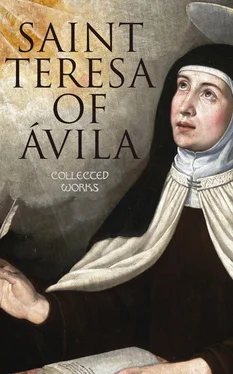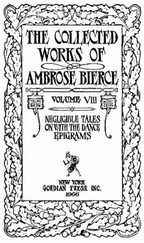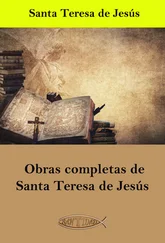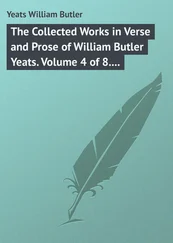Teresa of Avila
Saint Teresa of Ávila: Collected Works
The Life of St. Teresa, The Interior Castle, Way of Perfection
e-artnow, 2021
Contact: info@e-artnow.org
EAN 4066338119896
The Life of St. Teresa
The Interior Castle
Way of Perfection
Table of Contents
Introduction to the Present Edition.
St. Teresa's Arguments of the Chapters.
Preface by David Lewis.
Annals of the Saint's Life.
The Life of the Holy Mother Teresa of Jesus.
Prologue.
Chapter I.
Chapter II.
Chapter III.
Chapter IV.
Chapter V.
Chapter VI.
Chapter VII.
Chapter VIII.
Chapter IX.
Chapter X.
Chapter XI.
Chapter XII.
Chapter XIII.
Chapter XIV.
Chapter XV.
Chapter XVI.
Chapter XVII.
Chapter XVIII.
Chapter XIX.
Chapter XX.
Chapter XXI.
Chapter XXII.
Chapter XXIII.
Chapter XXIV.
Chapter XXV.
Chapter XXVI.
Chapter XXVII.
Chapter XXVIII.
Chapter XXIX.
Chapter XXX.
Chapter XXXI.
Chapter XXXII.
Chapter XXXIII.
Chapter XXXIV.
Chapter XXXV.
Chapter XXXVI.
Chapter XXXVII.
Chapter XXXVIII.
Chapter XXXIX.
Chapter XL.
The Relations.
Relation I.
Relation II.
Relation III.
Relation IV.
Relation V.
Relation VI.
Relation VII.
Relation VIII.
Relation IX.
Relation X.
Relation XI.
Introduction to the Present Edition.
Table of Contents
When the publisher entrusted me with the task of editing this volume, one sheet was already printed and a considerable portion of the book was in type. Under his agreement with the owners of the copyright, he was bound to reproduce the text and notes, etc., originally prepared by Mr. David Lewis without any change, so that my duty was confined to reading the proofs and verifying the quotations. This translation of the Life of St. Teresa is so excellent, that it could hardly be improved. While faithfully adhering to her wording, the translator has been successful in rendering the lofty teaching in simple and clear language, an achievement all the more remarkable as in addition to the difficulty arising from the transcendental nature of the subject matter, the involved style, and the total absence of punctuation tend to perplex the reader. Now and then there might be some difference of opinion as to how St. Teresa's phrases should be construed, but it is not too much to say that on the whole Mr. Lewis has been more successful than any other translator, whether English or foreign. Only in one case have I found it necessary to make some slight alteration in the text, and I trust the owners of the copyright will forgive me for doing so. In Chapter XXV., § 4, St. Teresa, speaking of the difference between the Divine and the imaginary locutions, says that a person commending a matter to God with great earnestness, may think that he hears whether his prayer will be granted or not: y es muy posible , "and this is quite possible," but he who has ever heard a Divine locution will see at once that this assurance is something quite different. Mr. Lewis, following the old Spanish editions, translated "And it is most impossible ," whereas both the autograph and the context demand the wording I have ventured to substitute.
When Mr. Lewis undertook the translation of St. Teresa's works, he had before him Don Vicente de la Fuente's edition (Madrid, 1861–1862), supposed to be a faithful transcript of the original. In 1873 the Sociedad Foto-Tipografica-Catolica of Madrid published a photographic reproduction of the Saint's autograph in 412 pages in folio, which establishes the true text once for all. Don Vicente prepared a transcript of this, in which he wisely adopted the modern way of spelling but otherwise preserved the original text, or at least pretended to do so, for a minute comparison between autograph and transcript reveals the startling fact that nearly a thousand inaccuracies have been allowed to creep in. Most of these variants are immaterial, but there are some which ought not to have been overlooked. Thus, in Chapter XVIII. § 20, St. Teresa's words are: Un gran letrado de la orden del glorioso santo Domingo , while Don Vicente retains the old reading De la orden del glorioso patriarca santo Domingo . Mr. Lewis possessed a copy of this photographic reproduction, but utilised it only in one instance in his second edition. 1
The publication of the autograph has settled a point of some importance. The Bollandists (n. 1520), discussing the question whether the headings of the chapters (appended to this Introduction) are by St. Teresa or a later addition, come to the conclusion (against the authors of the Reforma de los Descalços) that they are clearly an interpolation ( clarissime patet ) on account of the praise of the doctrine contained in these arguments. Notwithstanding their high authority the Bollandists are in this respect perfectly wrong, the arguments are entirely in St. Teresa's own hand and are exclusively her own work. The Book of Foundations and the Way of Perfection contain similar arguments in the Saint's handwriting. Nor need any surprise be felt at the alleged praise of her doctrine for by saying: this chapter is most noteworthy (Chap. XIV.), or: this is good doctrine (Chap. XXI.), etc., she takes no credit for herself because she never grows tired of repeating that she only delivers the message she has received from our Lord. 2The Bollandists, not having seen the original, may be excused, but P. Bouix (whom Mr. Lewis follows in this matter) had no right to suppress these arguments. It is to be hoped that future editions of the works of S. Teresa will not again deprive the reader of this remarkable feature of her writings. What she herself thought of her books is best told by Yepes in a letter to Father Luis de Leon, the first editor of her works: "She was pleased when her writings were being praised and her Order and the convents were held in esteem. Speaking one day of the Way of Perfection , she rejoiced to hear it praised, and said to me with great content: Some grave men tell me that it is like Holy Scripture. For being revealed doctrine it seemed to her that praising her book was like praising God." 3
A notable feature in Mr. Lewis's translation is his division of the chapters into short paragraphs. But it appears that he rearranged the division during the process of printing, with the result that a large number of references were wrong. No labour has been spared in the correction of these, and I trust that the present edition will be the more useful for it. In quoting the Way of Perfection and the Interior Castle (which he calls Inner Fortress !) Mr. Lewis refers to similar paragraphs which, however, are to be found in no English edition. A new translation of these two works is greatly needed, and, in the case of the Way of Perfection , the manuscript of the Escurial should be consulted as well as that of Valladolid. Where the writings of S. John of the Cross are quoted by volume and page, the edition referred to is the one of 1864, another of Mr. Lewis's masterpieces. The chapters in Ribera's Life of St. Teresa refer to the edition in the Acts of the Saint by the Bollandists. These and all other quotations have been carefully verified, with the exception of those taken from the works on Mystical theology by Antonius a Spiritu Sancto and Franciscus a S. Thoma, which I was unable to consult. I should have wished to replace the quotations from antiquated editions of the Letters of our Saint by references to the new French edition by P. Grégoire de S. Joseph (Paris, Poussielgue, 1900), which may be considered as the standard edition.
Читать дальше












